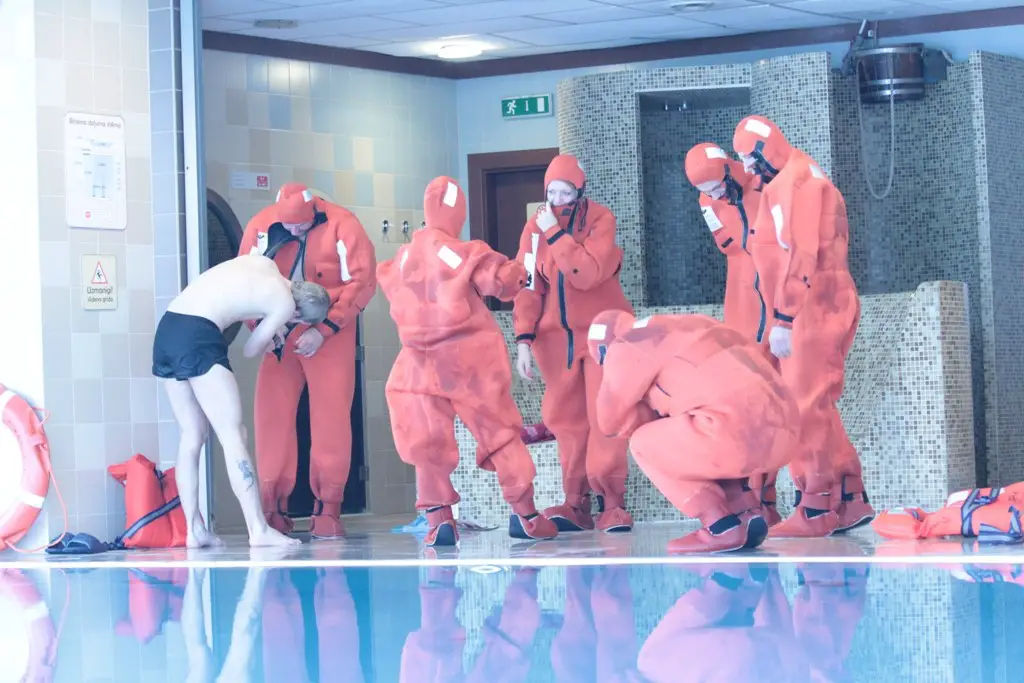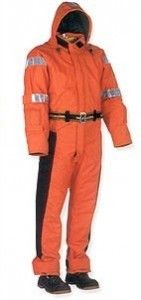SOLAS REQUIREMENT FOR ANTI EXPOSURE SUIT
CHAPTER 3, REG 7.3
An immersion suit, complying with the requirements of the Code, of an appropriate size, shall be provided for every person assigned to crew the rescue boat or assigned to the marine evacuation system party.
ADDITIONAL REQUIREMENTS FOR ANTI EXPOSURE SUIT
The anti-exposure suit shall be constructed with waterproof materials such that it:
- Provides inherent buoyancy of at least 70 N;
- Is made of material which reduces the risk of heat stress during rescue and evacuation operations;
- Covers the whole body with the exception of the head and hands and, where the Administration so permits, feet; gloves and a hood shall be provided in such a manner as to remain available for use with the anti-exposure suits;
- Can be unpacked and donned without assistance within 2 min;
- Does not sustain burning or continue melting after being totally enveloped in a fire for a period of 2 seconds;
- Is equipped with a pocket for a portable VHF telephone;
- Has a lateral field of vision of at least 120°.
An anti-exposure suit which also complies with the requirements of life-jackets may be classified as a life-jacket.
An anti-exposure suit shall permit the person wearing it:
- To climb up and down a vertical ladder of at least 5 m in length;
- To jump from a height of not less than 4.5 m into the water with feet first, without damaging or dislodging the suit, or being injured;
- To swim through the water at least 25 m and board a survival craft;
- To don a lifejacket without assistance; and
- To perform all duties associated with abandonment, assist others and operate a rescue boat.
An anti-exposure suit shall be fitted with a light complying with the requirements for life jackets.
An anti-exposure suit shall:
- If made of material which has no inherent insulation, be marked with instructions that it must be worn in conjunction with warm clothing;
- Be so constructed, that when worn as marked, the suit continues to provide sufficient thermal protection following one jump into the water which totally submerges the wearer and shall ensure that when it is worn in calm circulating water at a temperature of 5°C, the wearer’s body core temperature does not fall at a rate of more than 1.5°C per hour, after the first 0.5 hours.


Dear Sirs
We are a procurement company, based in Florida – USA, serving clients in Latin America, both South and Central America. Mainly Argentina, Bolivia, and Paraguay.
For one of our most important clients in Argentina (who in turn supplies the Argentina armed forces), we need to provide them the following :
22 x p/n: 3769AS130-5 (BOOTS FOR ANTIEXPOSURE SUIT CWU-86/P )
30 x p/n: 3769AS130-6 (BOOTS FOR ANTIEXPOSURE SUIT CWU-86/P )
30 x p/n: 3769AS130-7 (BOOTS FOR ANTIEXPOSURE SUIT CWU-86/P )
22 x p/n: 3769AS130-8 (BOOTS FOR ANTIEXPOSURE SUIT CWU-86/P )
240 x p/n: 3769AS120-1 (NEOPRENE CUFF )
120 x p/n: 3769AS110-1 (LATEX NECK )
7 x p/n: 1370AS502-3 (ROLL OF TAPE )
10 x p/n: MIL-T-83193 (SPOOL OF GREEN THREAD )
10 x p/n: 3497AS108-1 (NEOPRENE ADHESIVE )
100 x p/n: 1370AS502-2 (FABRIC PATCH )
Please inform price, brand, lead time and total shipping dimensions. Also certifications to provide with the items.
Thank you, regards
Adrian Laight
Company information
Smith Robson Corp
1842 Wiltshire Village Dr.
Wellington, FL 33414
(305)831-4892
adrian.laight@smithrobson.com